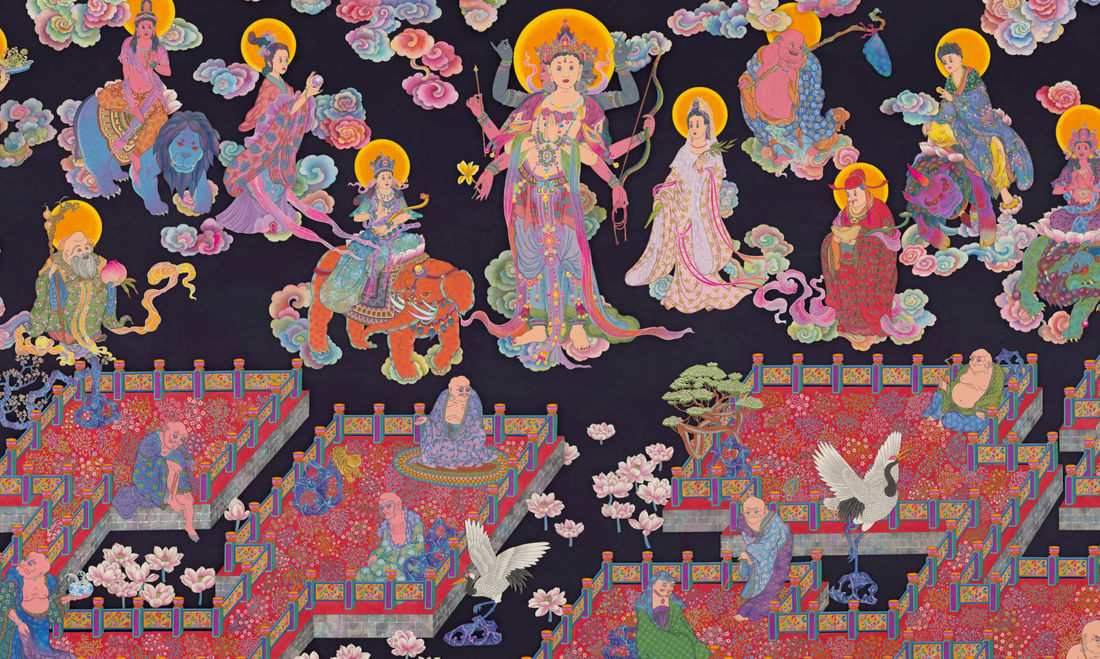
CONTEMPORARY INTERPRETATION AND CULTURAL REVIVAL OF EASTERN MYTHOLOGY
Author: Mengru Zhou
In today’s rapidly accelerating globalization and the gradual penetration of information technology, traditional mythological stories have not been eliminated by the times but have instead been revitalized in contemporary art. As an important part of global cultural heritage, Eastern mythology carries rich historical, folk, and regional cultures. These mythologies not only shaped the art, religion, and philosophical thoughts of East Asia but also deeply influenced modern society's aesthetic concepts and cultural values. This week, TEAOC.ART will explore the contemporary interpretation and cultural revival of Eastern mythology, examining how myths in contemporary art are fused with folk traditions, regional cultures, and modern technologies to form new artistic languages.

The Folk Roots and Visual Symbols of Eastern Mythology
Eastern mythology is deeply rooted in the folk traditions of various regions. These myths are not only the inheritance of stories but also symbols of cultural identity. In China, mythology often intertwines with historical records, religious beliefs, folk legends, and regional cultures. For example, The Classic of Mountains and Seas (山海经), one of China’s most important ancient mythological texts, not only presents mythical beasts and deities but also profoundly reflects ancient people's understanding of the universe, nature, and human society. The fantastical creatures and scenes in the text not only reveal the ancient people's mysterious interpretations of natural phenomena but also symbolize the belief systems and folk cultures of the time.
From Fujian to Shaanxi, the mythological stories of each region have their unique local characteristics and cultural symbols. For instance, the story of "Nezha" from Fujian is a typical folk myth. Nezha, a rebellious figure, carries strong local color, especially in Southern folk beliefs, where Nezha is both a protective deity and a heroic fighter. In traditional activities such as Fujian’s temple fairs, dramas, and annual festivals, the image of Nezha is constantly recreated, not only as a continuation of ancient beliefs but also as a reinforcement and recognition of regional culture.
In modern art, these traditional mythological elements and folk symbols are re-examined and deconstructed, becoming vehicles for artists to express profound reflections on social and cultural phenomena. For example, Chinese artist Boqing Chen reinterprets images of traditional Chinese stories through his paintings, combining explosive moments to reflect on the intersection of traditional culture and modern societal changes. His work Nova blends traditional mythology with folk elements, transforming an ancient myth into a contemporary artwork, thus achieving the modernization of mythological symbols.

Boqing Chen (Painter)
Based in Xiamen, b. 1988
Similarly, Liu Tianlian, a contemporary Chinese artist, reflects the collision between tradition and modernity in her works. Liu Tianlian’s paintings generate new visual structures through her unique "Secession" fine brushwork techniques and the use of traditional Chinese painting pigments, which exist outside traditional Chinese painting methods. She calls her process "horticultural grafting," a free wander between ancient and modern, Chinese and Western cultures, creating new meaning for old things. Her works breathe new life into traditional mythological symbols while providing contemporary art with a fresh visual language, highlighting the timeless appeal of Eastern culture.
The Intertwining of Regional Culture and Mythology: From Local to Global
Mythology is not only the inheritance of culture but also closely linked to regional culture. The customs, language practices, religious beliefs, and folk legends in regional cultures shape the unique characteristics of local myths. These myths often reflect a region's natural environment, social structure, and people's perceptions of life. For instance, the many deities in Indian mythology not only reflect India’s complex religious system but also deeply integrate with India’s natural landscapes and daily life. Temple murals, sculptures, and sacrificial ceremonies in India often use mythology as a theme, forming a rich expression of regional culture.
Chinese mythology, on the other hand, is often closely connected to natural landscapes. For example, the dragon in mythology is not only a symbolic creature in Chinese culture but also associated with China’s water systems, agricultural culture, and astronomical observations. The dragon is a water deity, a wind deity, and even a symbol of the emperor. Its image appears differently across various regional folklore, whether in the Yellow River basin or in the temple fair culture of the southeastern coast, deeply rooted in local traditions and social consciousness.
Modern artists often use regional symbols from traditional mythology to explore the tension between local culture and globalization. For example, Yang Fudong's works merge Chinese folk religious symbols with modern artistic language, using video works to tell the folk tales of Northern China, reflecting the conflict and integration between modern society and traditional culture.
At the same time, the symbols of Eastern mythology are increasingly making their way onto the global stage, becoming bridges for cross-cultural exchange. Artists, by deeply exploring and reconstructing regional cultures, link Eastern mythology with global social issues, creating an internationally oriented artistic language. This cross-regional and cross-cultural approach not only demonstrates the contemporaneity of myths but also promotes dialogue and communication between different cultures.

Tianlian Liu(Ink Painter)
Based in Beijing and New York, b. 1987
The Contemporary Revival of Eastern Mythology
Through a deep exploration of Eastern mythology, we not only see the strong roots of these myths in folk and regional cultures but also understand how they have been revitalized in contemporary art. Myths are not just memories of the past; through the creation of artists, they are continuously deconstructed and recreated, becoming an important tool for exploring modern society, philosophy, and the human spirit. Whether in the inheritance of traditional culture or the re-creation in a globalized context, Eastern mythology remains a vibrant force in artistic expression.
We hope to inspire the audience to rethink Eastern mythology, exploring its innovative forms and cultural values in contemporary art. By delving into the folk and regional cultures behind the myths, artists provide not only aesthetic enjoyment but also rich perspectives for reflecting on the complex relationships between tradition and modernity, locality and globalization.
